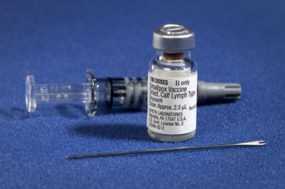Vaccine Basics
The smallpox vaccine protects people from smallpox by helping their bodies develop immunity to smallpox. The vaccine is made from a virus called vaccinia, which is a poxvirus similar to smallpox, but less harmful. The smallpox vaccine contains live vaccinia virus, not a killed or weakened virus like many other vaccines. For that reason, people who are vaccinated must take precautions when caring for the place on their arm where they were vaccinated, so they can prevent the vaccinia virus from spreading.
The vaccine does not contain the smallpox virus and cannot give you smallpox.
For most people with healthy immune systems, live virus vaccines are effective and safe. Sometimes a person getting a live virus vaccine experiences mild symptoms such as rash, fever, and head and body aches. In certain groups of people, complications from the vaccinia virus can be severe. The Smallpox Vaccine Safety page has more information about who is more likely to experience these side effects.

Other live virus vaccines currently used include measles, mumps, rubella, and chickenpox.
Smallpox vaccination can protect you from smallpox for about 3 to 5 years. After that time, its ability to protect you decreases. If you need long-term protection, you may need to get a booster vaccination. Find out who should get smallpox vaccine.
Historically, the vaccine has been effective in preventing smallpox infection in 95% of those vaccinated. In addition, the vaccine was proven to prevent or substantially lessen infection when given within a few days after a person was exposed to the variola virus.
Routine smallpox vaccination among the American public stopped in 1972 after the disease was eradicated in the United States.
Related Resources
- Page last reviewed: July 12, 2017
- Page last updated: July 12, 2017
- Content source:


 ShareCompartir
ShareCompartir
